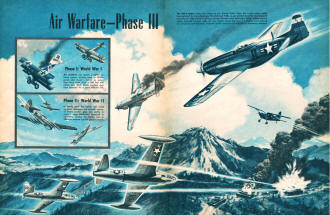|
If Frank Tinsley was still writing articles for
Air Trails magazine as he did in November of 1950, he would be up to at least Air Warfare Phase IX,
depending on how you count our air wars / engagements. The
Korean War officially ran from
June 25, 1950 – July 27, 1953, so the Air Warfare Phase III installment was right at the beginning.
Vietnam
(November 1, 1955 – April 30, 1975) would have been Phase IV,
the Gulf War
(August 2, 1990 – February 28, 1991) counts as Phase V,
Bosnia
(April 6, 1992 – December 14, 1995) counts as Phase VI,
Yugoslavia
(March 24, 1999 – June 10, 1999) is Phase VII, the
Iraq War
(March 20, 2003 – December 18, 2011) is Phase VIII, and
Afghanistan
(October 7, 2001 – December 28, 2014) wraps it up - until the next - at
Phase IX. Lots of other smalls engagements fell in-between, like Libya and Mogadishu. His artwork
would also include stealth aircraft and drones.
Air Warfare - Phase III
by Frank Tinsley
Phase I: World War I
Air warfare was mainly a battle between planes, starting when an ill-tempered pilot shook a fist
at an enemy flyer. Next come duels at 100 feet with pistols and rifles; finally machine guns were mounted
for a more effective kill.
Phase II: World War II
In early part the fighter still acted as plane destroyer, but greater number of heavy caliber guns
and ability to carry a large bomb-load increased its versatility, turning the fighter into an effective
weapon against ground targets.

The third phase came into being on the Korean front. Here the fighter plane really demonstrated its
many-sidedness. The Lockheed F-80s, as yet untried in battle and designed primarily for high-altitude
fighting, proved effective tank destroyers, using rockets against enemy armored columns, while not only
liaison planes but even T-6 trainers were presses into service to spot Red tanks. Propeller-driven American
aircraft were in immediate demand.
Posted April 4, 2016
|



